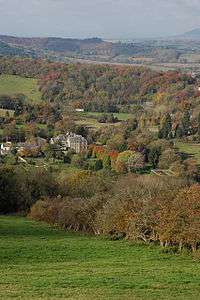Troy House
| Troy House | |
|---|---|
 | |
| General information | |
| Status | Empty |
| Town or city | Monmouth |
| Country | Wales |
| Coordinates | 51°47′55.55″N 2°42′46.34″W / 51.7987639°N 2.7128722°WCoordinates: 51°47′55.55″N 2°42′46.34″W / 51.7987639°N 2.7128722°W |
| Completed | 1684 |
| Designations | Grade II* listed |
Troy House is a Welsh historic house, on a "ducal" scale,[1] north-east of Mitchel Troy, Monmouthshire. The original house belonged to Blanche Herbert, Lady Troy, of the Herbert family of Raglan Castle, who owned great estates in South Wales as Marquesses of Worcester and later Dukes of Beaufort. The present structure, overlooking the River Trothy was constructed from 1681 to 1684 as a wedding present for Charles Somerset by his father, Henry Somerset, 1st Duke of Beaufort.[1] Troy House is a Grade II* listed building.[2]
Description
The house is very large, "three bays deep but no less than thirteen bays wide",[1] in a style that was very modern for the date of design, "a hipped roof over a regularly fenestrated block."[1] Some 19th-century authors wrongly attributed the design of the house to Inigo Jones.[3]
The interior contains "three good-quality, typically Jacobean decorated ceilings."[1]
History
In 1667 Henry Somerset succeeded his father to the title of Marquess of Worcester. Henry, a staunch supporter of Charles II, restored the family fortunes and built a series of residences to replace the slighted Raglan Castle. He started with Great Castle House, in Monmouth in 1673, continued with Badminton House in Gloucestershire, and built the new Troy House as a wedding gift to his son Charles. There is a painting by Hendrick Danckerts which is in Monmouth Museum which is approximately dated to 1672 which shows Troy House in a panorama of Monmouth.[4]
In 1682 Charles Somerset married Rebecca Child and acquired the title of Marquess of Worcester. Between 1682 and 1699 he expanded Troy House and rebuilt the facade in neoclassical style. The house remained the property of the Somersets until the death of Henry Somerset, 8th Duke of Beaufort in 1899. At this time, the family consolidated its estates around Badminton House in Gloucestershire and the descendants of the 8th Duke auctioned off the 1,670-acre (6.8 km2) Troy estate along with most of their Welsh properties. In 1872, a gazeteer reported that the cradle belonging to Henry V together with the alleged armour Henry V wore at Agincourt were said to be at "the mansion" in Mitchel Troy.[5]
Troy House was purchased by the Good Shepherd Sisters in 1904 and converted to a convent school. The catholic nuns expanded the estate with a chapel, a hostel and service buildings. In 1935 the institution was converted into an approved school with state financing. The building gradually deteriorated, and in the 1980 the school moved out. The Unification Church approached the municipality with an offer to buy the abandoned property, but this was rejected.
In 2009 proposals were put forward by a property developer to divide the house into residential units. The proposed enabling development would involve the construction of two entirely new wings which were intended to accommodate more units than would the original house. Preservationists divided over the proposals: SAVE Britain's Heritage concurred with the developer's analysis, others, including the Georgian Group expressed fears that the plans would constitute significant overdevelopment of the house and site.[6] As of 2011, the house remains empty. In 2015 Monmouthshire Council funded a protected species survey required for consideration of the redevelopment proposals.[7]
Images
 A Panorama of Monmouth with Troy House, c.1672 by Hendrick Danckerts
A Panorama of Monmouth with Troy House, c.1672 by Hendrick Danckerts.jpg) Front View of Troy House by J. Gardnor; engraved by J. Gardnor and J. Hill; 1793
Front View of Troy House by J. Gardnor; engraved by J. Gardnor and J. Hill; 1793 Troy House Monmouth, between about 1890 and 1900
Troy House Monmouth, between about 1890 and 1900 Troy House and surrounding countryside in 2007
Troy House and surrounding countryside in 2007
Monmouth Troy House station
In 1857 the Coleford, Monmouth, Usk and Pontypool Railway built a railway station north of Troy House. It was inaugurated as Monmouth Troy House station, but the name was soon reduced to Monmouth Troy. It was closed to passenger traffic in 1959 and completely shut down in 1964. In 1985 the brick station building was carefully disassembled and in 1987-1999 rebuilt on the site of Winchcombe railway station of the heritage Gloucestershire Warwickshire Railway.[8]
Notes
- 1 2 3 4 5 Newman, p. 391.
- ↑ "Troy House, Mitchel Troy" at britishlistedbuildings.co.uk
- ↑ Dugdale, James (1819). The new British traveler or, Modern Panorama of England and Wales. J. and J. Cundee, London. p. 576.
- ↑ "A Panorama of Monmouth with Troy House, c.1672 by Hendrick Danckerts". Your Paintings. BBC.
- ↑ Wilson, John Marius (1872). Descriptive Imperial Gazetteer of England and Wales: Entry for MONMOUTH.
- ↑ Devine, Darren (2009, February 17). If Monmouth mansion plans rejected, Troy 'will be ruined'. walesonline.co.uk.
- ↑ Skellon, Katharine (25 September 2015). "Council's bid to help save Monmouth mansion". South Wales Argus. Retrieved 2 July 2016.
- ↑ Troy Station Viaduct, Monmouthshire. Transactions of the Ancient Monument Society, 1988, vol 32, p. 160.
References
- Newman, John (2000). Gwent/Monmouthshire. The Buildings of Wales. Penguin. ISBN 0-14-071053-1.